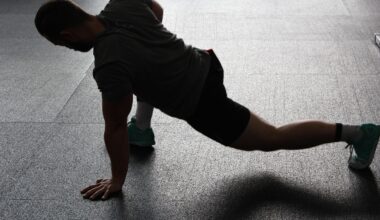Programming Strategies for Improving Core Stability with Kettlebells
Kettlebell training has gained widespread popularity due to its effectiveness in enhancing strength, flexibility, and endurance. The unique design of kettlebells promotes dynamic movements that engage the core muscles, thereby improving stability. A solid core is essential not just for athletic performance but also for everyday activities. Incorporating kettlebell workouts focused on core stability can transform your fitness regime. To adapt your kettlebell training for core stability, prioritize exercises that require balance and coordination. Such exercises activate multiple muscle groups, particularly the abdominals, obliques, and lower back. Examples of useful kettlebell exercises include Turkish Get-Ups, Kettlebell Swings, and Single-Arm Rows. It is vital to maintain proper form throughout each exercise to maximize benefits while minimizing injury risks. Paying attention to the kettlebell’s position will also help ensure you’re effectively activating your core muscles. Progressing from basic to advanced moves allows for a gradual increase in difficulty. Consistency in your training program is key to seeing improvement over time. Take note of how your body responds and adjust the training variables accordingly for optimal results.
Understanding core stability is crucial for anyone, particularly those participating in kettlebell training. Core stability refers to the ability to maintain proper body alignment and control during dynamic movements. When performing kettlebell exercises, focus on maintaining a tight core as this not only prevents injury but also enhances performance. One strategy for enhancing core stability is to integrate unilateral kettlebell exercises into your program. These exercises force the body to stabilize itself under load, which is particularly beneficial for core engagement. Some examples include Kettlebell Single-Arm Snatches and Kettlebell Farmers Walks. Unilateral movements challenge the core more than bilateral exercises, enhancing overall stability. Another important aspect is ensuring that your workout routine includes a variety of kettlebell exercises targeting different angles and muscle groups. This diversity helps develop a balanced core, optimizing strength, and endurance. Consider incorporating supersets that alternate between core-targeting kettlebell movements and traditional resistance training. This approach maximizes your time in the gym while also providing an intense focus on core development. Gradually increase weights as you grow stronger for ongoing improvement.
Progressive Overload and Core Stability
To effectively improve core stability through kettlebell training, apply the principle of progressive overload. This entails gradually increasing the resistance used in your exercises. As your core becomes stronger, you should strive to increase the weight of the kettlebell or the complexity of the exercises performed. This method not only enhances muscle growth but also challenges your stability. Start with manageable weights to ensure that your form remains correct. This attention to proper form will sow the seeds for greater strength and stability. Be sure to incorporate a range of kettlebell movements to target the abs, lower back, and obliques specifically. Variations in grip, stance, and body position can further create additional challenges within your routine. As you progress, focus on compound exercises that employ multiple joints, like Kettlebell Deadlifts or Swings. Integrating high-intensity intervals utilizing kettlebells can also be effective. Short bursts of intense work followed by brief recovery periods have proven to be excellent for core enhancement. Keep track of your progress to help in designing your workouts intelligently and ensuring continued growth.
Supplementing kettlebell workouts with various core conditioning exercises can further enhance your core stability. Planks, for instance, can be performed with a kettlebell, creating additional instability and requiring greater engagement from your core muscles. Rotate through different plank variations like side planks to target the obliques effectively. Another effective method for building core strength via kettlebells includes using them in anti-rotation exercises, such as the Kettlebell Anti-Rotation Press. These exercises challenge your core to fight against rotational forces, thus improving stability. Incorporating stability-focused workouts into your programming, such as balance exercises on an unstable surface, can complement your kettlebell routines. Using tools like stability balls or Bosu balls during kettlebell workouts can also provide added benefits. For example, performing kettlebell squats on a Bosu ball challenges your balance considerably. Ensure you include adequate recovery periods in your programming to prevent over-training. Additionally, nutrition plays a significant role in core stability development. Pay attention to maintaining a well-balanced diet, which includes sufficient protein and hydration to support muscle recovery.
Focus on Breathing Techniques
In kettlebell training, proper breathing techniques are crucial for maximizing core stability. Engaging your diaphragm during exercises allows for better intra-abdominal pressure, which enhances your stability. Focus on mastering your breathing pattern, which should ideally be synchronized with your movements. Exhaling during exertional portions of your exercises, such as during swaying or lifting, helps tighten your core. Conversely, inhaling during the transition allows for better control throughout your workout. Promoting effective communication between your breath and movement provides a more dynamic, engaging experience. Incorporate specific breathing exercises before your kettlebell sessions. Techniques like diaphragmatic or box breathing preparations are excellent for enhancing your focus. This conscious activation of the core muscles prepares your body for performance. Additionally, visualize your core engaging throughout your kettlebell program. Visualization techniques are powerful tools to improve focus during exercise, especially when executing complex movements. Practice mindfulness and keep a steady rhythm with your breath to optimize core engagement. Consistent practice with these techniques is essential to see improvement over time, particularly in performance and core strength.
Creating a structured kettlebell training program that emphasizes core stability involves careful planning. Start by determining your fitness goals, such as desired weight, muscle gain, or overall health improvement. Based on your goals, design a balanced weekly routine split into different focus areas. Begin with foundational exercises before progressing to more advanced movements. For instance, start with basic swings and move towards complicated lifts as your core stabilizes. Aim to include at least three sessions per week with varied intensities. Assign one day for lighter, technique-focused workouts, while others can be more strenuous, incorporating compound lifts. Consider also fitting in mobility work to promote recovery and flexibility, allowing better performance in kettlebell exercises. This inclusion will further aid in maintaining optimal core function. It is also beneficial to record your workouts to observe your overall progress and ensure your goals are being met. Analyze when adjustments may be necessary to keep your training stimulating and effective. Celebrate your progress and revisit your goals as your strength and stability increase through consistent kettlebell training.
Conclusion and Final Tips
In conclusion, effective programming strategies for improving core stability with kettlebells involve a variety of methods. Keep the principles of progressive overload, varied exercises, and attention to breathing at the forefront of your training. Create a structured workout plan that gradually challenges your core while ensuring balanced training. Don’t forget to complement kettlebell exercises with core conditioning workouts that engage your abdominal muscles from multiple angles. Incorporate stability-focused drills that can maximize your core engagement, and observe your breathing patterns during exercises to promote stability. Nutrition and recovery are equally important; pay attention to what you consume to fuel your workouts and allow for muscle recovery. Flexibility in your programs is crucial; listen to your body and modify your routines as necessary. Regularly assess your progress and keep pushing beyond your comfort zone to achieve your goals. Remember, consistency and dedication will pay off in the long run. By implementing these strategies, you will undoubtedly notice positive changes in your core strength and stability, leading to improved performance in all physical activities.


